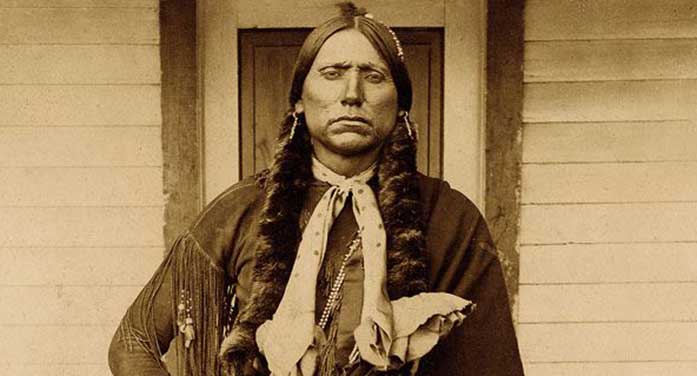 My previous column told the story of Cynthia Ann Parker. Kidnapped as a nine-year-old in an 1836 Comanche raid, she was assimilated into the tribe, married a war chief with whom she had three children, and was then ‘rescued’ by Texas Rangers in 1860. She died a decade later, miserable and unwilling to reintegrate into white society.
My previous column told the story of Cynthia Ann Parker. Kidnapped as a nine-year-old in an 1836 Comanche raid, she was assimilated into the tribe, married a war chief with whom she had three children, and was then ‘rescued’ by Texas Rangers in 1860. She died a decade later, miserable and unwilling to reintegrate into white society.
The story, however, doesn’t end there. Her eldest child – known as Quanah Parker – created quite a stir.
There’s some dispute as to when Quanah’s father – the Comanche war chief Peta Nocona – died. Some sources said it was during the skirmish when Cynthia Ann was ‘rescued.’ Others, including Quanah, claimed it was several years later.
Either way, Quanah found himself an orphan at some point in his early teens. Comanche society didn’t necessarily make this easy, particularly for someone who’d been relatively privileged while his father was alive.
But Quanah was a resourceful guy. He had courage, charisma and adaptability. As subsequent events demonstrated, he was a survivor who instinctively knew how to work the odds.
He developed a following and became a war chief. A staunch enemy of the whites who’d taken his mother and baby sister, he also fought other Indians. He was very good at it. Referring to his early years, S.C. Gwynne’s Empire of the Summer Moon describes him as having “killed many Indians and white people in his short life.”
By the 1870s, though, the Comanche were running out of road. They’d enjoyed more than two centuries of success – first against the other tribes whom they’d conquered and supplanted, and then against early European encroachment. Now, however, they’d collided with a technologically sophisticated culture that also had the advantage of vastly greater numbers. As post-Civil War America relentlessly expanded westward, it had no place for nomadic hunter/raiders.
Thus, on June 2, 1875, Quanah and his band surrendered to the U.S. military and entered the Comanche reservation in Oklahoma. And the erstwhile implacable foe became an advocate for adaptation to the white world.
Quanah was still a young man – perhaps 27 – at the time of his surrender. He had no intention of becoming a nonentity.
 So he cultivated relationships, including one with Ranald Slidell Mackenzie, the ruthlessly effective army officer who’d pursued him. In our parlance, you might say Quanah knew how to read the room. Over time, he often became the go-to guy for U.S. authorities dealing with the Comanche.
So he cultivated relationships, including one with Ranald Slidell Mackenzie, the ruthlessly effective army officer who’d pursued him. In our parlance, you might say Quanah knew how to read the room. Over time, he often became the go-to guy for U.S. authorities dealing with the Comanche.
Quanah also took an interest in his mother’s heritage and began using her surname. When the famous cattleman Charles Goodnight asked him what he was called, he responded with two options – “Mr. Parker or Quanah.” Eventually, he became acquainted with the Texas branch of her family.
A good chunk of Quanah’s modus operandi would now be described as corruption. Favours were exchanged, bribes were taken. It was how business was done on the frontier. As Gwynne puts it, “Quanah was merely playing the game the way everyone else did.”
Relations with white cattlemen were an example. Quanah used his influence to facilitate their leasing of unused reservation land for pasture. In return, he received a monthly retainer and discreet assistance in building his private herd.
He also became personally familiar with prominent people, including a sitting president. While in office, Teddy Roosevelt went wolf hunting with him and came to dinner at Star House, the large two-storey dwelling Quanah built for himself and his family.
In a speech at the 1910 Texas State Fair, Quanah had this to say: “I used to be a bad man. Now I am citizen of the United States. I pay taxes same as you people do. We are the same people now.”
There was, no doubt, much hyperbole in this, including the self-designation of having been a bad man. One suspects Quanah never regretted or felt guilty about his warrior days.
But the world had moved on and the old ways were no longer feasible. A practical man adapted and focused on winning the new game.
Still, one thing that never changed was Quanah’s love for his lost mother. With the help of a Texas cousin, he located Cynthia Ann’s burial plot, arranged for her to be reinterred close to his home in Oklahoma and spoke eloquently at the December 1910 graveside ceremony.
He was buried next to her three months later, struck down by rheumatism-induced heart failure.
Troy Media columnist Pat Murphy casts a history buff’s eye at the goings-on in our world. Never cynical – well, perhaps a little bit. For interview requests, click here.
The opinions expressed by our columnists and contributors are theirs alone and do not inherently or expressly reflect the views of our publication.
© Troy Media
Troy Media is an editorial content provider to media outlets and its own hosted community news outlets across Canada.

